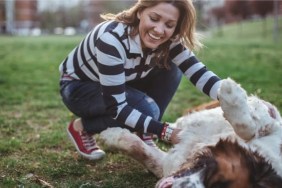
At a time when there are serious issues facing the dog-loving community — Breed Specific Legislation, overcrowded shelters, animal cruelty — CBS chose to lighten the mood with a fun new reality show about dog training. The ratings-guaranteed ingredients for Dogs in the City‘s first episode? Models, a skateboarding Bulldog, and Justin Silver — a slick-haired New Yorker who specializes in dog aggression.
Silver is actually the star of the show: dog walker by day, comedian by ambition. And there’s nothing wrong with the formula. Training your dog should be fun, even funny at times. But like all seemingly simple endeavors with the potential to go horribly wrong, the person in charge should at least appear to know what he’s doing.
I believe Silver is probably a very nice guy who means well. In each of the three scenarios presented in the show’s debut, however, I found some of his approach to be disconcerting, if not downright harmful.
In the first segment, we meet Beefy, a Bulldog who dictates where his owner sleeps, eats, walks, etc. Silver suggests buying a baby gate to help establish a bit of separation between dog and owner. He hopes to teach the dog that being alone is fun. Or at least tolerable.
Silver’s initial thought seems like the right idea: Create an inviting “alone-zone” for the dog. With the owner on one side of the gate, I expected Silver to set Beefy up with a treat-stuffed kong, a prized toy, and a comfy blanket on the other. But Silver waits to give Beefy the kong until after he complains (barks) about the arrangement. In other words, he rewards the barking behavior.
He then describes Beefy, whose most serious problem (ostensibly) is not getting what he wants, as having separation anxiety. Sort of akin to a doctor telling a person with a cold he that has pneumonia. The former is very treatable, doesn’t usually get out of hand. The other is a serious matter that is not cured with a cough drop. Or five minutes behind a baby gate.
In the next segment, Silver “helps” the head of a modeling agency with her dog Charlotte. The problem: Any time a human or canine enters the woman’s office, Charlotte growls, lunges, and charges. Or, allegedly, bites.
Silver is well aware of this, yet he still recommends bringing in another (smaller) dog to “see what happens.” As predicted, Charlotte goes after the dog and indeed makes contact. What kind of trainer allows a dog to practice this behavior? What kind of human orchestrates a scenario knowing a smaller animal will be harmed?
Unacceptable. Period.
In the last segment, Silver demonstrates his technique for teaching “leave it.” It involves introducing a high-value item (turkey) and then physically pushing the dog’s chest or knocking her under the chin when she goes for the meat. Problem number one: Leave it can be, and usually is, taught without using physical force.
Problem number two: The person he’s instructing is a petite, nine-year-old girl, while the animal is a hundred-pound Bernese Mountain Dog. I’ve never seen an obedience command that couldn’t be taught without physical corrections (in other words, positive reinforcement can be used to teach any cue). And if you’re teaching a child to train a dog, safety alone says that positive reinforcement is the only way to go.
I’ll give Dogs in the City one more chance tonight. I hope I’m pleasantly surprised by what I see.









